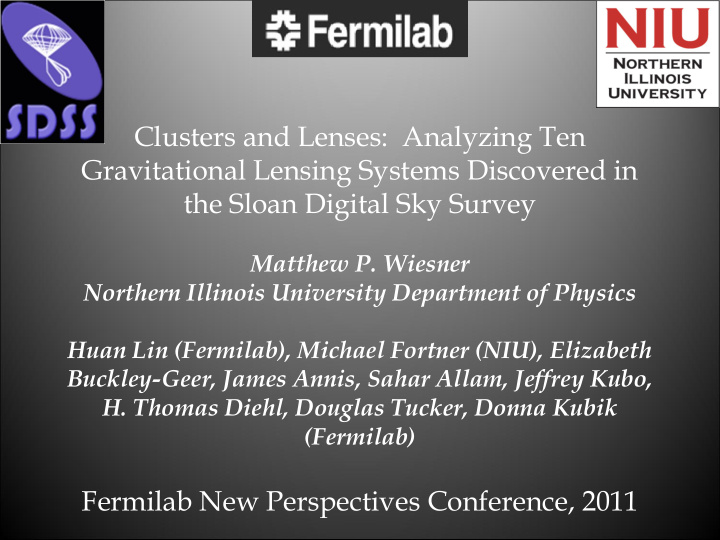



Clusters and Lenses: Analyzing Ten Gravitational Lensing Systems Discovered in the Sloan Digital Sky Survey Matthew P. Wiesner Northern Illinois University Department of Physics Huan Lin (Fermilab), Michael Fortner (NIU), Elizabeth Buckley-Geer, James Annis, Sahar Allam, Jeffrey Kubo, H. Thomas Diehl, Douglas Tucker, Donna Kubik (Fermilab) Fermilab New Perspectives Conference, 2011
Outline 1) Introduction to the astrophysics 2) The data and how it was taken 3) Properties of the galaxy clusters 4) Properties of the gravitational lenses 5) Initial cosmological conclusions
1) The Astrophysics
What is a galaxy cluster? • Collection of galaxies • Dark matter presence Abell 2255 (SDSS.org) (Penn State University)
What is a gravitational lens? • System where light bends due to presence of mass • Effect of General Relativity (light follows curvature) (NASA/CXC/M.Weiss)
2) The Data
The ten systems • Color images from g,r,i filters • Found in Sloan Digital Sky Survey • Follow-up data taken at WIYN telescope • Each includes a blue arc and a galaxy cluster
SDSS J1209+2640 The Richest Cluster
SDSS J1038+4849 The Happiest Cluster
The telescopes The Wisconsin-Yale-Indiana- The Sloan Digital Sky NOAO (WIYN) Telescope Survey (SDSS) Telescope NOAO/AURA/NSF SDSS.org
3) Properties of the Galaxy Clusters
How do we find galaxy MaxBCG Method clusters? for Finding Galaxy Clusters (Koester et al. 2007) Look for: (1)Groups of galaxies where density increases near center (2)Constant color (3)Central Brightest Cluster Galaxy (BCG)
Defining a cluster galaxy Counting Galaxies— Quantifying Richness • N gals , number within 1 Mpc Used Fortran program to find objects that were: A.Galaxies, not stars B.Within 1 Mpc of BCG C.Within 2 σ of particular color D.At least as bright as 0.4L* (min brightness criterion)
A. Galaxy- Star Separation Find stellar locus by plotting magnitude difference vs. variable aperture magnitude C. Selecting Cluster Members
Results for N gals
Finding N 200 Radius of − = 0 . 6 1 r 0 . 156 ( N ) h Mpc sphere within 200 gal which ρ =200 ρ c (Hansen et al. 2 2005) 3 H ( z ) ρ = ( z ) c π 8 G
Finding M 200 α N N M 200 (Johnston et. al. 2007). = M ( N ) M 200 200 200 200 | 20 20 N 200 from MaxBCG catalog, mass found from weak lensing.
Finding Velocity Dispersion Velocity N σ = + ln A B ln 200 dispersion v 25 (Becker et. al. 2008) • Found σ v from spectroscopy in N 200 bins.
4) Properties of the Gravitational Lenses
Einstein Radius Modeling the lens as a • Describes size of gravitational lens. For a sphere perfect circle (Einstein ring) this is the radius of the ring. SDSS J0900+2234
Properties of the lens Einstein radius 4 GM D θ = ds E 2 c D D s d Lens Mass 2 c D D 2 = θ d s M E 4 G D ds Narayan & Bartelmann (1997)
θ 2 c D Velocity Dispersion σ = E s v π 4 D ds Narayan & Bartelmann (1997)
5) Initial Cosmological Conclusions
Λ CDM A • Standard model of cosmology – Cosmological principle Disagreement – Expansion of universe with Big Bang, cosmological redshift with Λ CDM? – Flat spatial geometry – Cosmological constant – Dark matter cold, non-baryonic, dissipationless (cannot cool by Gralla et. al. 2010 radiating), collisionless NASA/WMAP Science Team
A Disagree- ment with Λ CDM? • Higher than expected concentrations: Cluster cores collapsing faster than we thought? Why? (Broadhurst and Barkana 2008)
Conclusion • We studied ten galaxy clusters and gravitational lenses • Found richness and mass of clusters • Found size and mass of lenses • Found that current predictions for Einstein radius as a function of cluster mass do not match data
Acknowledgements • Fermilab Graduate Student Association • Dr. Huan Lin • Dr. Michael Fortner • The Fermilab Experimental Astrophysics Group • Dr. Laurence Lurio and the NIU Department of Physics
Questions? http://catalog.instructionalimages.com/einsteinquestion-pi-27.html
Recommend
More recommend